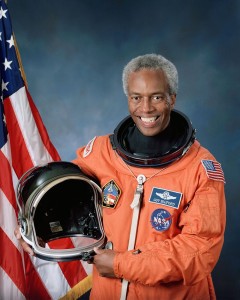
By Jim Lovell
Whenever I pass through St. Louis, I always take a moment to admire the great Spencer Taylor mural at Lambert Field that celebrates the contributions of African-Americans to aerospace.
Many of the people I meet — especially people of color — think the space program is the exclusive domain of white, middle-aged men with crew cuts. But the reality is that African-Americans have played an active and important part in space exploration since the very beginnings of the program.
In addition to the 14 African-American astronauts, there have been countless more scientists, mathematicians, physicists, astronomers, doctors and engineers who have made significant scientific, engineering and medical contributions.
Take for example, Robert Shurney. A physicist from Tennessee State University, it was Dr. Shurney who designed the tires for the moon buggy used during the Apollo 15 mission in 1972. His ingenious design used wire mesh in the place of rubber to save weight yet still provide the needed flexibility.
Dr. Vance Marchbanks, a heart surgeon and medical specialist for NASA, helped develop ways to monitor astronauts’ vital signs during space flight. It was Dr. Marchbanks who was responsible for John Glenn’s health during America’s first orbital flight.
George Carruthers, an astronautical engineer, built the camera that was carried to the moon on Apollo 16. He also designed and built a combination telescope and camera used on the shuttle missions. Some of the most enduring images from space were made us ing Dr. Carruthers’ cameras.
Christine Darden, a mathematician and mechanical engineer, has been with NASA since 1966. Dr. Darden is a recognized leader in the reduction of shock waves from spacecraft wings and nose cones.
Patricia Cowings, a psychologist from the University of California, has been conducting NASA space flight research for more than 20 years. Dr. Cowings was instrumental in developing ways astronauts could use biofeedback to reduce space sickness and headaches in space.
Meanwhile, African-American astronauts have played important roles and even led some of the most demanding and dangerous space missions. Guion Bluford, a former Air Force pilot and first African-American in space, logged 688 hours over four space shuttle missions, beginning with his first flight in 1983.
He was followed by Frederick Gregory, another Air Force pilot, and graduate of the Air Force Academy, who made his first space flight in 1985. Gregory went on to command Space Shuttle Discovery in 1989 and served as mission commander of the Space Shuttle Atlantis in 1991.
Charles Bolden, a graduate of the U.S. Naval Academy and Major General in the Marine Corps, logged two space shuttle missions in 1986 and 1990 before serving as mission commander on Atlantis in 1992 and Discovery in 1994.
Mae Jemison was the first African-American woman in space. During an eight-day mission on Endeavor in 1992, she conducted space-sickness experiments and conducted research on bone loss in zero gravity. In addition to a B.S. in chemistry and a degree in medicine, Dr. Jemison also holds a degree in African-American studies.
Dr. Bernard Harris, flight surgeon on the Columbia in 1993, was the first African-American to walk in space during his flight on the Discovery in 1995. During that same mission, Harris conducted experiments on the Russian MIR spacecraft after a linkup in orbit.
Astronauts merit special attention because, in addition to bringing a special set of skills, they’re also willing to risk their lives. Two of America’s astronauts of African decent have made the ultimate sacrifice. Ronald McNair, a much-loved physicist from New York, was aboard the 1986 Challenger Mission that exploded above Cape Canaveral. The other was Maj. Robert J. Lawrence, who was killed in a crash during a training mission in 1967. Both were highly respected by their peers. Both believed in the space program.
Sadly, most young people would not recognize any of these names. For these African-Americans to achieve their position within the space program required extraordinary courage and perseverance. They often had to work harder and longer to soar over the set backs.
Soaring Above Setbacks was the name of a recent exhibit at Anne Arundel Community College in Maryland currated by Jim Jackson, the college’s coordinator of multiethnic recruitment, a graduate of Annapolis, a licensed pilot and a space program historian. The exhibit chronicles the extraordinary accomplishments of people like Shurney, Darden and Jemison and the setbacks they had to endure.
While many would consider them exclusive, Jackson notes there are many interesting parallels between the civil rights movement and the space program. In 1957, while the nation was torn by the integration of the Little Rock schools, the country was also galvanized by the launch of Sputnik. In 1962, while the Freedom Riders were registering voters in the South, John Glenn bound us all by orbiting the earth. And, at the end of the 1960s, Americans walked on the moon while also mourning the loss of Martin Luther King.
“It’s important to remember that, throughout the entire civil rights movement, there were African-Americans also involved in the space program,” notes Jackson. “Blacks have always participated in the nation’s progress. Black scientists, engineers and astronauts understood how important it was for African-Americans to be at the forefront of a national scientific and technological endeavor.”
Jackson hopes Soaring Above Setbacks will inspire young African-Americans, “We’re in the era of technology. The ultimate expression of technology is the space program. My goal is to prove to young African-Americans that they, too, can participate and be leaders in one of the greatest adventures of all time.”
source: quest.nasa.gov




